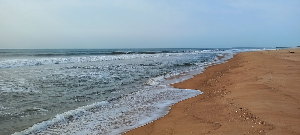Coastal communities east of the Volta Estuary, including Kporkporgbor, Fuveme,
Dzita, Keta, Agavedzi, Salakope, Amutsinu, and Denu face significant challenges
due to climate change. These communities are trapped between the encroaching
sea and the flooding of Keta Lagoon, experiencing both physical and socio-economic impacts.
Coastal erosion, tidal waves, lagoon floods, and rainfall inundation are the
main issues exacerbated by climate change, threatening livelihoods, infrastructure, and the very existence of these communities.
The dual threat of coastal erosion and tidal waves from the sea, alongside lagoon floods and rainfall inundation, has exacerbated the vulnerability of these areas.
This article delves into the physical and socio-economic impacts of climate change on these communities and explores potential solutions through comprehensive coastal management plans and the implementation of climate resilience projects through mitigation and adaptation mechanisms.
Physical Impacts of Climate Change:
Coastal Erosion and tide Waves:
The coastal communities east of the Volta Estuary have been experiencing severe coastal erosion for decades now, primarily driven by rising sea levels and increased frequency of tidal waves.
Studies have shown that the coastline in this area is retreating at an alarming rate, leading to the loss of land and property (Appeaning Addo et al., 2018). For instance, the community of Fuveme has seen significant portions of its land eroded, displacing residents and destroying infrastructure (Armah et al., 2005). Today, Fuveme, as a community, no longer exists on Ghana’s map.
Lagoon Floods and Rainfall Inundation:
In addition to the challenges posed by the sea, these communities also contend with lagoon floods and rainfall inundation. The increased intensity and unpredictability of rainfall have led to frequent flooding of the Keta Lagoon, affecting nearby communities such as Keta, Havedzi, and Agavedzi (Boateng, 2010). These floods not only damage homes and infrastructure but also disrupt agricultural activities, which are the primary livelihood for many residents.
Socio-Economic Impacts:
The physical impacts of climate change have profound socio-economic
consequences. The loss of land and property due to coastal erosion forces
communities to relocate, often to areas with fewer resources and opportunities
(Mensah et al., 2016). Displacement disrupts social networks and traditional ways of life, leading to a loss of cultural heritage.
Moreover, the frequent flooding of homes and farmlands exacerbates the loss of means of livelihood. As agricultural yields decline due to inundation, communities struggle to maintain their livelihoods. This economic strain is compounded by the damage to infrastructure, like streets, roads, and footbridges, which hinders access to markets, healthcare, and education facilities (Nubukpo et al., 2011).
The physical impacts of climate change also directly translate into socio-economic challenges. The communities east of the Volta Estuary predominantly rely on fishing, farming, and tourism. Coastal erosion and tidal waves destroy fishing infrastructure, such as boats, outboard motors, and nets, while lagoon floods and rainfall inundations ruin crops and farmland. This double jeopardy significantly reduces income and food security, pushing many families into poverty.
Solutions: Coastal Management and Resilience Projects:
Comprehensive Coastal Management Plan:
Addressing the challenges faced by these communities requires a holistic approach. A comprehensive coastal management plan should integrate both hard and soft engineering solutions. Hard engineering solutions, such as revetments, sea walls, and groynes, can provide immediate protection against coastal erosion and tidal waves. However, these must be complemented by soft engineering solutions,
nature-based solutions, such as beach nourishment and the restoration of mangroves, to ensure long-term sustainability (Aheto et al., 2011).
Lessons can be drawn from the transboundary resilience of the West African Coastal Areas. Investment Project (WACA ResIP) implemented in Senegal, Côte d'Ivoire, and Saô Tomé and Príncipe, Togo, and Benin. This project focuses on enhancing coastal resilience through a hybrid approach, a well-balanced combination of grey engineering and green solutions.
Coastal Management Plan:
A comprehensive Coastal Management Plan for the coast east of the Volta Estuary
should include:
Integrated Coastal Zone Management (ICZM):
This approach involves coordinating the efforts of different ministries, departments, agencies, and other stakeholders to manage coastal resources sustainably. It includes monitoring coastal changes, regulating development, and promoting practices that reduce environmental impact.
Community Engagement and Education:
Educating local communities about climate change and involving them in decision-making processes can improve resilience. Empowered communities are better
equipped to adapt to changes and implement local solutions.
Disaster Preparedness and Response:
Establishing Early Warning Systems (EWS) and Disaster Response Plans (DRP)
can help mitigate the impacts of tidal waves and floods. These systems should be
tailored to the specific needs and vulnerabilities of each community.
Coastal Protection Works:
Drawing inspiration from the WACA ResIP, coastal protection works could include:
Construction of Sea Defenses. Building seawalls, groynes, and revetments can protect shorelines from erosion and tidal waves. These structures should be designed to withstand future sea level rise and increased storm intensity.
Restoration of Mangroves and Wetlands:
Mangroves and wetlands act as natural buffers against storm surges and erosion.
Restoring these ecosystems can provide long-term protection and enhance
biodiversity.
Dune Rehabilitation: Stabilizing sand dunes through planting vegetation and constructing barriers can reduce the impact of coastal erosion. Dunes act as natural barriers that absorb wave energy and protect inland areas.
WACA ResIP 2: Building on Transboundary Lessons:
The West Africa Coastal Areas Management Programme: Resilience Investment
Project 2 (WACA ResIP 2) offers a promising framework for enhancing coastal
protection and resilience. Drawing lessons from WACA ResIP 1, implemented in
Togo and Benin can provide valuable insights. In Togo and Benin, the integration of coastal protection infrastructure with community-based adaptation strategies proved effective.
For instance, the construction of breakwaters and groynes and the restoration
of mangrove ecosystems helped reduce coastal erosion while providing habitats for local fisheries (World Bank, 2018).
Applying these lessons to the communities east of the Volta Estuary can help tailor solutions to the specific needs and conditions of the region. ResIP 2 should prioritize collaborative planning with local communities, ensuring that interventions are context-specific and sustainable.
Importance of Social Sub-Projects:
In addition to physical infrastructure, social sub-projects play a critical role in building community resilience to climate change. These projects should focus on improving livelihoods and enhancing the adaptive capacity of communities. Initiatives such as vocational training, microfinance schemes, and the promotion of climate-resilient agriculture can empower residents to diversify their income sources and reduce dependency on vulnerable sectors (UNDP, 2019).
Educational programs and awareness campaigns are also essential for fostering a
culture of resilience. By equipping communities with knowledge and skills, they can better anticipate and respond to climate-related challenges.
Conclusion:
Communities east of the Volta Estuary are caught between the sea and the lagoon.
facing severe physical and socio-economic impacts from climate change. Coastal
Erosion, tidal waves, lagoon floods, and rainfall inundation threaten their livelihoods and well-being.
However, through a comprehensive coastal management plan and the implementation of resilience projects such as WACA ResIP 2, there is hope for mitigating these impacts.
By learning from successful interventions in neighbouring countries and prioritizing community engagement, it is possible to enhance the resilience of these vulnerable coastal communities. Social sub-projects that improve livelihoods and build adaptive capacity are crucial for ensuring that these communities not only survive but thrive in the face of climate change.
The writer is an Environmentalist and Climate Change Activist with the Centre for Natural Resources and Environmental Management (CNREM)
Opinions of Tuesday, 2 July 2024
Columnist: Joel Degue















